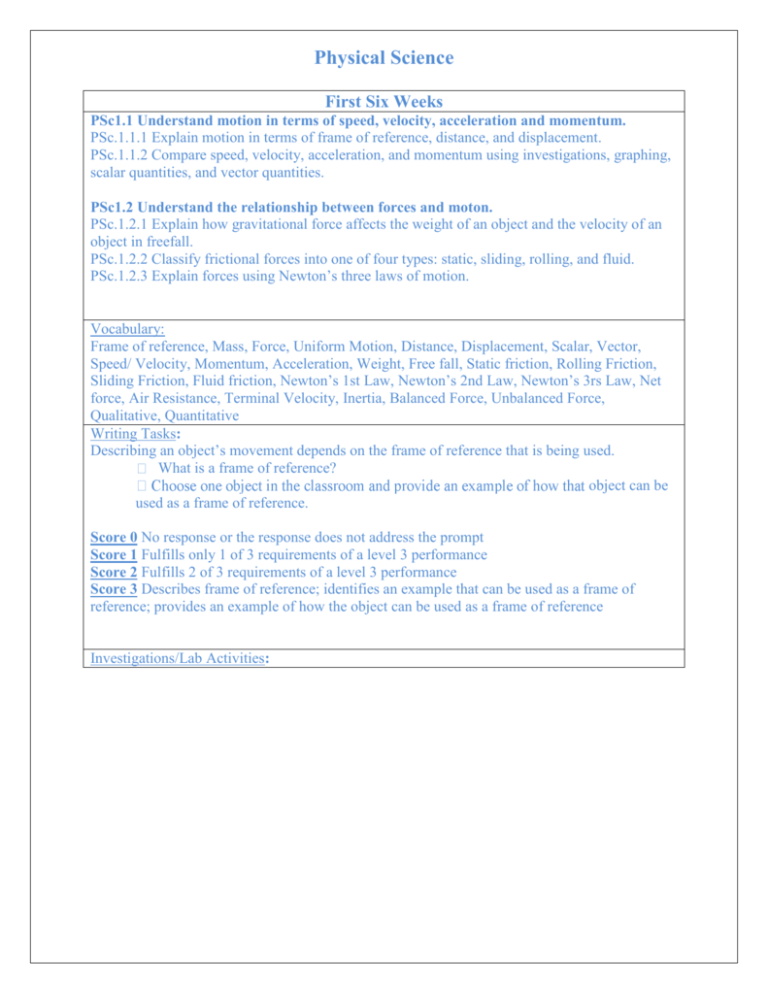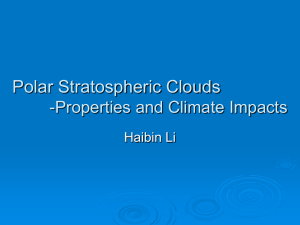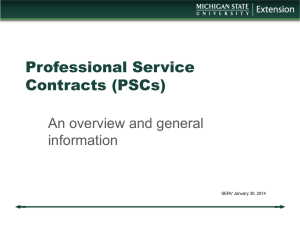Physical Science Pacing
advertisement

Physical Science First Six Weeks PSc1.1 Understand motion in terms of speed, velocity, acceleration and momentum. PSc.1.1.1 Explain motion in terms of frame of reference, distance, and displacement. PSc.1.1.2 Compare speed, velocity, acceleration, and momentum using investigations, graphing, scalar quantities, and vector quantities. PSc1.2 Understand the relationship between forces and moton. PSc.1.2.1 Explain how gravitational force affects the weight of an object and the velocity of an object in freefall. PSc.1.2.2 Classify frictional forces into one of four types: static, sliding, rolling, and fluid. PSc.1.2.3 Explain forces using Newton’s three laws of motion. Vocabulary: Frame of reference, Mass, Force, Uniform Motion, Distance, Displacement, Scalar, Vector, Speed/ Velocity, Momentum, Acceleration, Weight, Free fall, Static friction, Rolling Friction, Sliding Friction, Fluid friction, Newton’s 1st Law, Newton’s 2nd Law, Newton’s 3rs Law, Net force, Air Resistance, Terminal Velocity, Inertia, Balanced Force, Unbalanced Force, Qualitative, Quantitative Writing Tasks: Describing an object’s movement depends on the frame of reference that is being used. What is a frame of reference? object can be used as a frame of reference. Score 0 No response or the response does not address the prompt Score 1 Fulfills only 1 of 3 requirements of a level 3 performance Score 2 Fulfills 2 of 3 requirements of a level 3 performance Score 3 Describes frame of reference; identifies an example that can be used as a frame of reference; provides an example of how the object can be used as a frame of reference Investigations/Lab Activities: Physical Science Second Six Weeks PSc.2.1 Understand the types, properties, and structure of matter. PSc.2.1.1 Classify matter as: homogeneous or heterogeneous; pure substance or mixture; element or compound; metals, nonmetals, or metalloids; solution, colloid, or suspension. PSc.2.1.2 Explain the phases of matter and the physical changes that matter undergoes PSc.2.1.3 Compare physical and chemical properties of various types of matter. PSc.2.1.4 Interpret the data presented in the Bohr model diagrams and dot diagrams for atoms and ions of elements 1 through 18. PSc2.2 Understand chemical bonding and chemical interactions. PSc.2.2.1 Infer valence electrons, oxidation number, and reactivity of an element based on its location in the Periodic Table. PSc.2.2.2 Infer the type of chemical bond that occurs, whether covalent, ionic, or metallic, in a given substance. PSc.2.2.3 Predict chemical formulas and names for simple compounds based on knowledge of bond formation and naming conventions. PSc.2.2.4 Exemplify the law of conservation of mass by balancing chemical equations. PSc.2.2.5 Classify types of reactions such as synthesis, decomposition, single replacement, or double replacement. PSc.2.2.6 Summarize the characteristics and interactions of acids and bases. PSc.2.3 Understand the role of the nucleus in radiation and radioactivity. PSc.2.3.1 Compare nuclear reactions including alpha decay, beta decay and gamma decay; nuclear fusion and nuclear fission. PSc.2.3.2 Exemplify the radioactive decay of undtable nuclei using the concept of half-life. Vocabulary: Homogeneous, heterogeneous, pure substance, mixture, element, compound, solution, colloid, suspension, Tyndall Effect, heat, freezing, melting, vaporization, condensation, evaporation, solvent, solute, insoluble, solubility curves, concentration, saturated, unsaturated, supersaturated, dilute, concentrated, density, metals, nonmetals, metalloids, luster, conductivity, ductility, malleability, reactivity, physical property, chemical property, charge, relative mass, proton, neutron, electron, atomic number, average atomic mass, neutral atom, ion, isotope, isotopic notation, Bohr model, Lewis‐dot diagram, energy levels, valence electrons, Oxidation number, ionic bond, covalent bond, metallic bond, binary compound, polyatomic ion, coefficient, Law of Conservation of Matter, synthesis, decomposition, single replacement, double replacement, hydrocarbon, inorganic acid, base, Arrhenius Theory, pH scale, neutralization, conductivity, alpha particles, beta particles, gamma rays, nuclear fission, nuclear fusion, nuclear energy, half life, radioactive decay Writing Tasks: Matter changes from one state to another state during a phase change. Explain how the processes of evaporation and boiling are similar. Explain how the processes of evaporation and boiling are different. Score 0 No response or the response does not address the prompt Physical Science Score 1 Fulfills only 1 of 2 requirements of a level 2 performance Score 2 Provides an explanation for how evaporation and boiling are similar; provides an explanation for how evaporation and boiling are different Investigations/Lab Activities: Physical Science Third Six Weeks PSc.3.1 Understand the types of energy, conservation of energy and energy transfer. PSc.3.1.1 Explain thermal energy and its transfer. PSc.3.1.2 Explain the law of conservation of energy in a mechanical system in terms of kinetic energy, potential energy and heat. PSc.3.1.3 Explain work in terms of the relationship among the applied force to an object, the resulting displacement of the object, and the energy transferred to an object. PSc.3.1.4 Explain the relationship among work, power and simple machines both qualitatively and quantitatively. PSc3.2 Understand the nature of waves. PSc.3.2.1 Explain the relationships among wave frequency, wave period, wave velocity, amplitude, and wavelength through calculation and investigation. PSc.3.2.2 Compare waves (mechanical, electromagnetic, and surface) using their characteristics. PSc.3.2.3 Classify waves as transverse or compressional (longitudinal). PSc.3.2.4 Illustrate the wave interactions of reflection, refraction, diffraction, and interference. PSc.3.3 Understand electricity and magnetism and their relationship. PSc.3.3.1 Summarize static and current electricity. PSc.3.3.2 Explain simple series and parallel DC circuits in terms of Ohm’s law PSc.3.3.3 Explain how current is affected by changes in composition, length, temperature, and diameter of wire. PSc.3.3.4 Explain magnetism in terms of domains, interactions of poles, and magnetic fields. PSc.3.3.5 Explain the practical application of magnetism. Vocabulary: thermal energy, specific heat capacity, heat, temperature, latent heat, conduction, convection, radiation, mechanical energy, work, power, simple machine, complex machine, wedge, screw, inclined plane, pulley, wheel and axle, lever, efficiency, law of conservation of energy, actual mechanical advantage, ideal mechanical advantage, longitudinal (compressional) wave. Amplitude, rarefaction, compression, period, frequency, wave velocity, wavelength, mechanical wave, electromagnetic wave, surface wave, medium, reflection, refraction, wave interference, constructive interference, destructive interference, super position, diffraction, radar, sonar, conduction, friction, induction, static electricity, current electricity, circuit, open circuit, closed circuit, Ohms Law, DC circuit, series circuit, parallel circuit, voltage, resistance, resistivity, magnetic domain, magnetic pole, magnetic field, solenoid, electromagnet, generator, motor, Writing Tasks: A wave has a frequency of 55 Hz and a speed of 35 m/s. Score 0 No response or the response does not address the prompt Score 1 Fulfills only 1 of 2 requirements of a level 2 performance Score 2 Calculates the wavelength of the wave; describes the change in wavelength as frequency increase Physical Science Investigations/Lab Activities:






